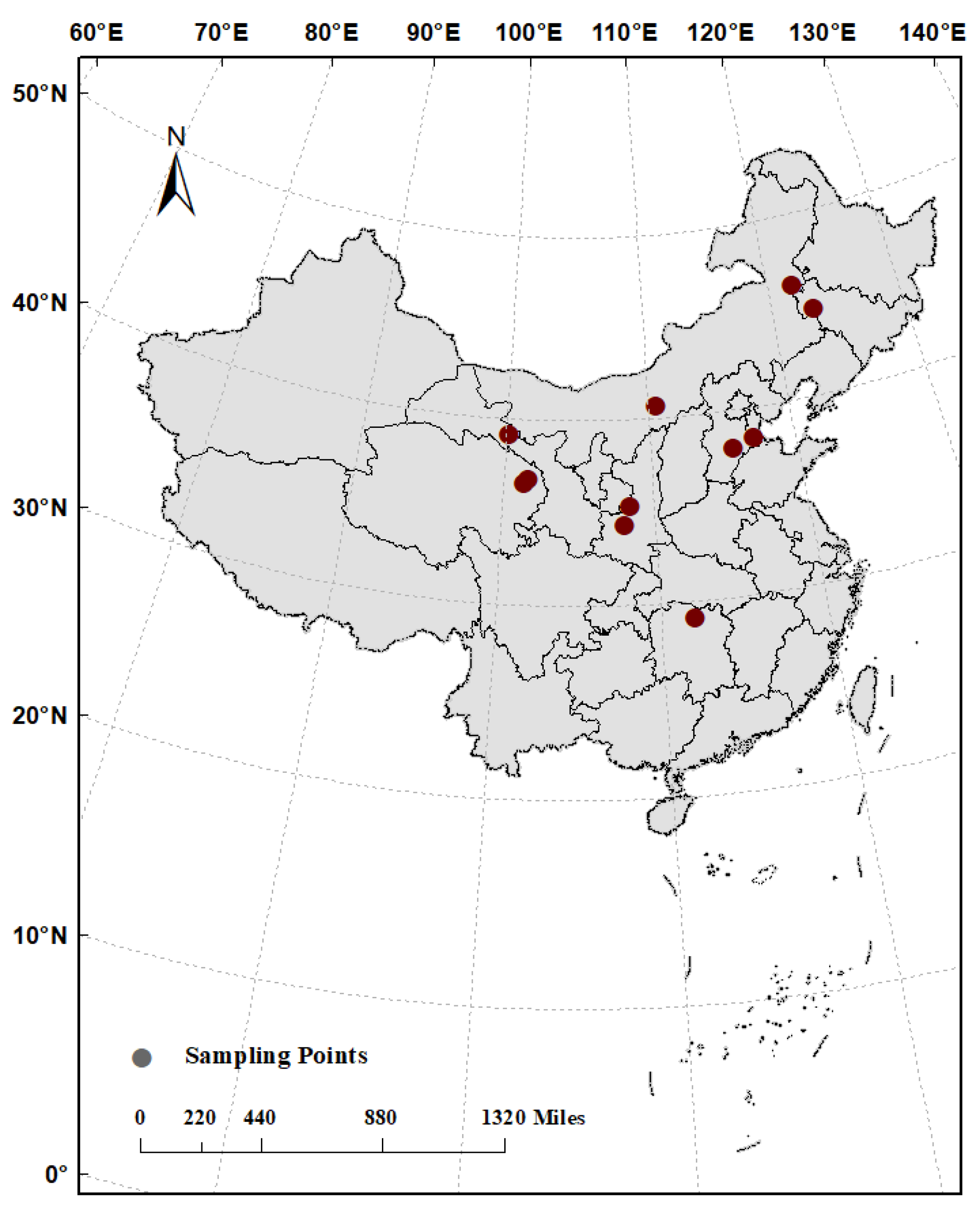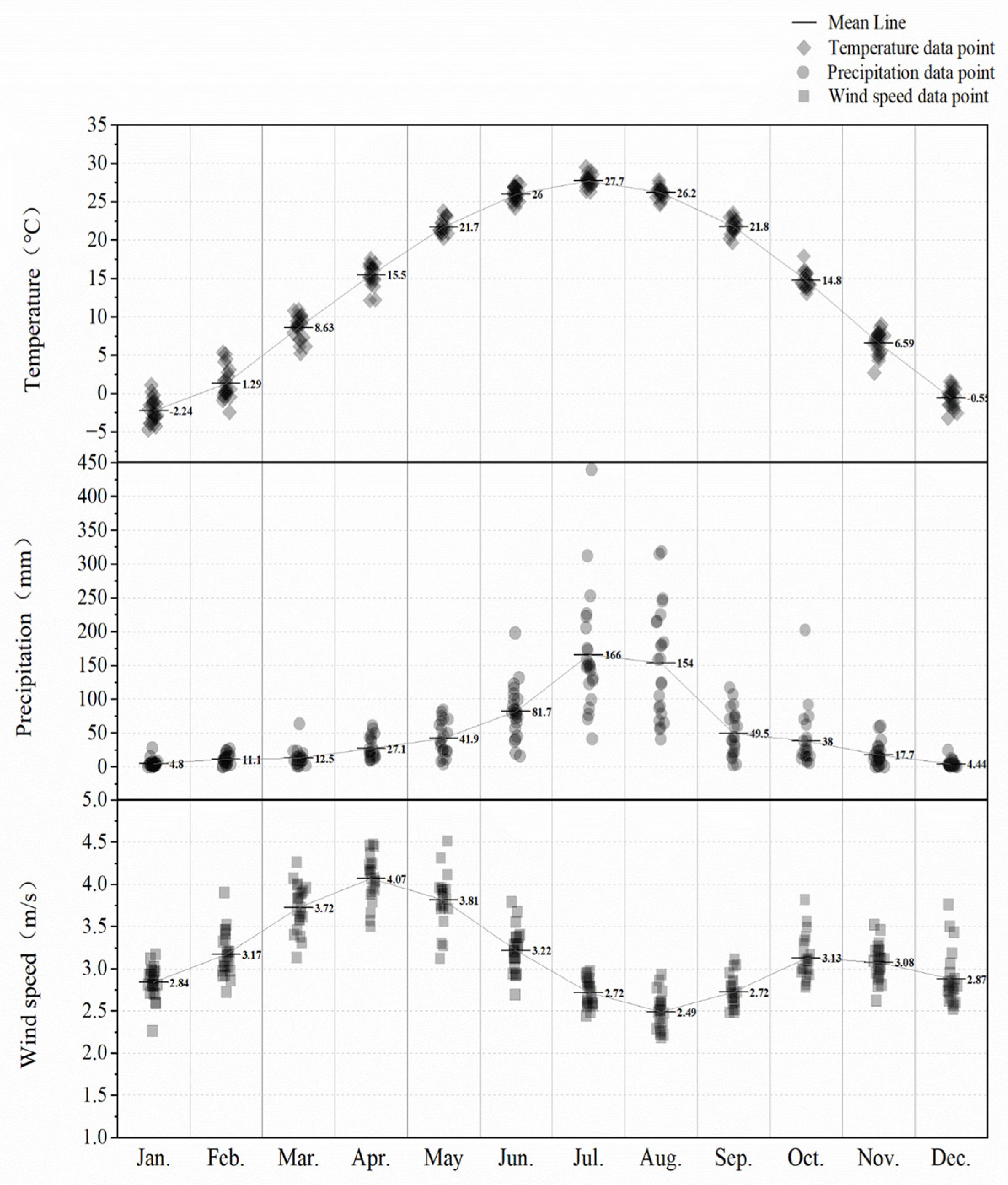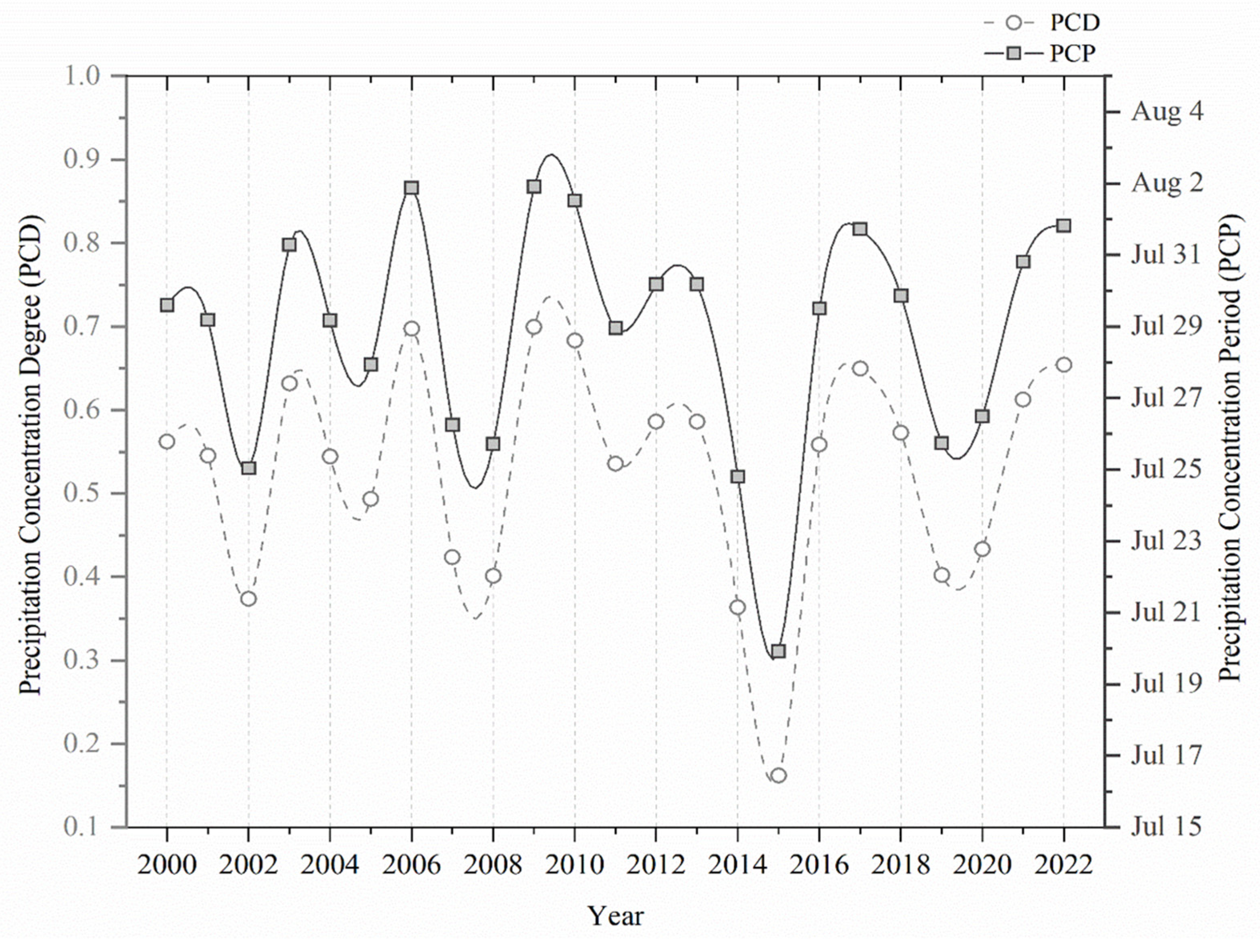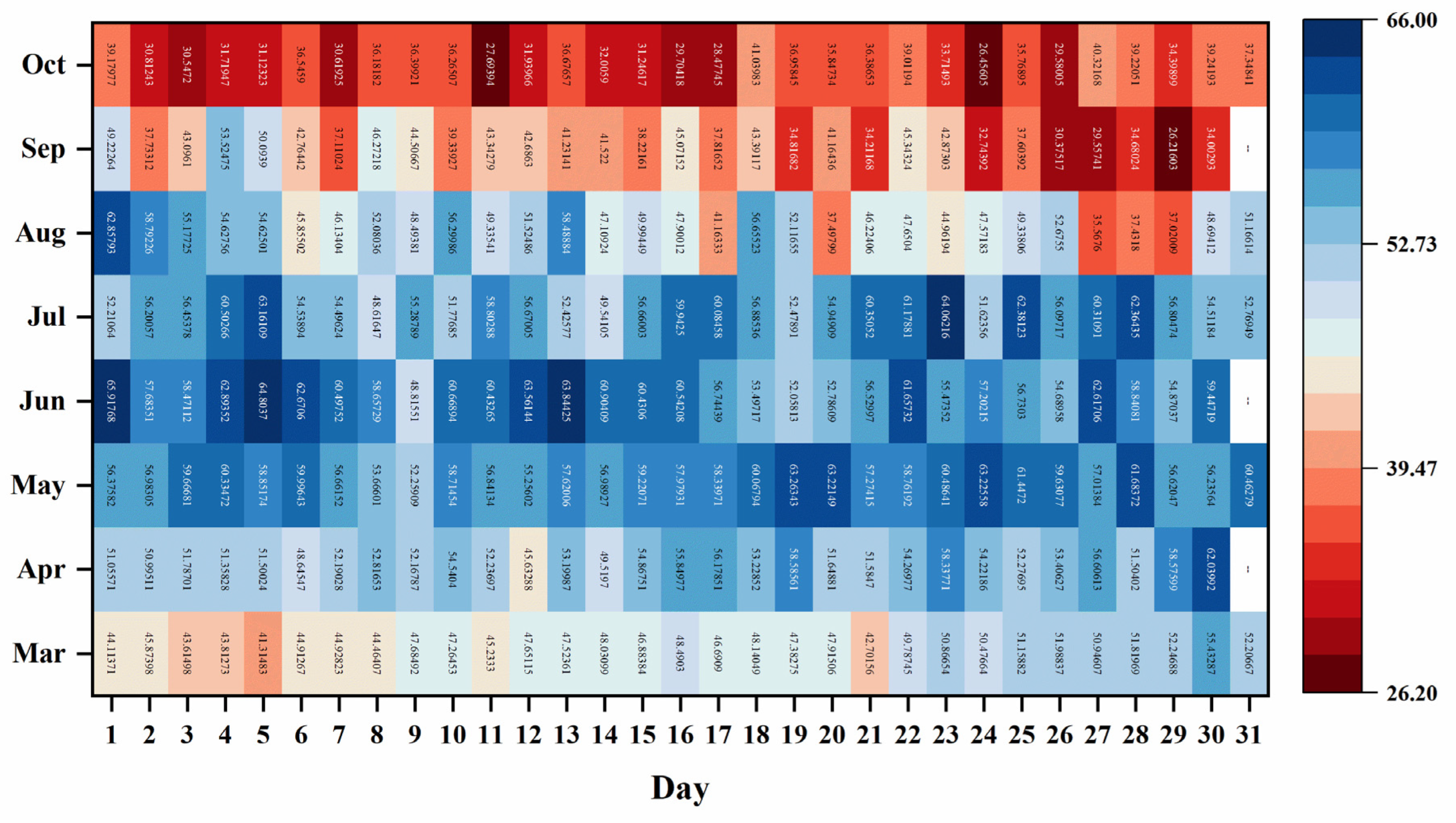A Method of Coupling Lucerne Quality with Meteorological Data to Evaluate the Suitability of Hay Harvest
Abstract
:1. Introduction
2. Materials and Methods
2.1. Index Selection
- Fall dormancy level: Lucerne fall dormancy refers to a physiological dormancy phenomenon caused by reduced daylight and declining temperatures in northern latitudes during the autumn season [18]. A fall dormancy level provides essential guidance for lucerne introduction and cultivation zoning [19]. In turn, lucerne with different fall dormancy levels have different nutrient content due to the variations in regional weather; thereby, the fall dormancy level is closely related to the nutritional quality of lucerne hay. For statistical analysis, lucerne varieties in the database are categorized into five groups based on the fall dormancy level: extreme non-dormancy, non-dormancy, semi-dormancy, dormancy, and extreme dormancy.
- Crude protein content: Crude protein content is one of the most common criteria for evaluating lucerne hay quality [20]. Compared with other forage quality indicators, such as acid, neutral detergent fiber, and relative feed value, natural drying has a more significant impact on the crude protein content of lucerne. Therefore, crude protein content is chosen as an indicator to characterize the influence of climatic factors on hay quality.
- Fiber content: Neutral detergent fiber (NDF) and acid detergent fiber (ADF) content are important indicators of the nutrient content of forages, which is the fiber component of forage, and the NDF and ADF indicators are closely related to the quality of forage, and they are more and more widely used in the evaluation of the nutritional value of forage.
- Weather factors: Harvesting early or late can result in a decline in hay quality, and weather conditions are essential considerations in determining the timing of harvest. As mentioned in the Introduction Section, excessive rainfall and high humidity are the primary causes of poor lucerne hay quality as it is reported that rain could lead to a loss of crude protein losses by approximately 35% [21]. Weather factors such as temperature, precipitation, and relative humidity directly affect the drying rate and quality of hay, especially during the physiological drying stage, which usually lasts for 12 to 24 h. Therefore, average temperature, precipitation, relative humidity, surface temperature, wind speed, and total solar radiation within 24 h of the harvest day have been selected in this study.
2.2. Data Compilation
2.3. Principal Component Analysis
2.4. Unified Scoring Dimensions
2.5. Classification of Harvest Suitability
3. Results
3.1. Results of Principal Component Analysis
3.2. Validation Results of the Evaluation Method
3.2.1. Overview of the Verification Site
3.2.2. Precipitation Concentration Period at the Verification Site
3.2.3. Suitability Evaluation for Hay Harvesting
4. Discussion
4.1. Influence of Meteorological Factors on the Quality of Lucerne Hay during Drying Period
4.2. The Cutting Period and Stubble Times Were Determined by the Suitability Scoring Formula
4.3. Adjusting Lucerne Harvesting Methods According to the Suitability of Hay Harvesting
5. Conclusions
Author Contributions
Funding
Data Availability Statement
Conflicts of Interest
References
- Grant, R.J.; Ferraretto, L. Silage review: Silage feeding management: Silage characteristics and dairy cow feeding behavior. J. Dairy Sci. 2018, 101, 4111–4121. [Google Scholar] [CrossRef] [PubMed]
- Ouellet, V.; Tremblay, G.F.; Laroche, J.-P.; Bélanger, G.; Binggeli, S.; Jégo, G.; Charbonneau, E. Modeling whole farm profitability and environmental performance of four alfalfa-grass binary mixtures in eastern Canadian dairy farms. Agron. J. 2021, 113, 4047–4063. [Google Scholar] [CrossRef]
- Testa, G.; Gresta, F.; Cosentino, S.L. Dry Matter and Qualitative Characteristics of Alfalfa as Affected by Harvest Times and Soil Water Content. Eur. J. Agron. 2011, 34, 144–152. [Google Scholar] [CrossRef]
- Sun, H.-R.; Yang, X.-J.; Chen, Z.; Zhang, B.-Y.; Ren, Y.-T. Water demand pattern and irrigation quota of alfalfa in Yanyang District. J. Grassl. 2017, 25, 1227. [Google Scholar] [CrossRef]
- Yang, X. Impacts of Climate Change on Yield, Water Utilisation and Soil Nutrients in Crop Production Systems on the Loess Plateau. Lanzhou University Institutional Repository. 2019. Available online: https://ir.lzu.edu.cn//handle/262010/337999 (accessed on 3 April 2024).
- Yang, X.; Liu, L.; Zhu, X.Q.; Yu, C.Q.; Li, J.H. Grey correlation analysis between alfalfa yield and meteorological factors in the Tibet valley region. J. Grassl. 2016, 24, 198–203. [Google Scholar]
- Gallego, A.; Hospido, A.; Moreira, M.T.; Feijoo, G. Environmental assessment of dehydrated alfalfa production in Spain. Resour. Conserv. Recycl. 2011, 55, 1005–1012. [Google Scholar] [CrossRef]
- Han, K.J.; Pitman, W.D.; Chapple, A. Moisture Concentration Variation of Silages Produced on Commercial Farms in the South-Central USA. Asian-Australas. J. Anim. Sci. 2014, 27, 1436–1442. [Google Scholar] [CrossRef] [PubMed]
- Nieman, C.C.; Coblentz, W.K.; Moore, P.A.; Akins, M.S. Effect of Poultry Litter Application Method and Rainfall and Delayed Wrapping on Warm-Season Grass Baleage. Agronomy 2023, 13, 1896. [Google Scholar] [CrossRef]
- Zhong, S.; Zhang, X.; Yang, Y.; Yang, Y. Effects of lactic acid bacteria and cellulase on silage quality of alfalfa with different moisture content. J. Anim. Nutr. 2017, 29, 1821–1830. [Google Scholar]
- Liu, L.Y. Research on the Influence Mechanism of Environmental Factors on Nutrients during Alfalfa Drying Process and Field Regulation Strategy. Ph.D. Thesis, Inner Mongolia Agricultural University, Hohhot, China, 2019. Available online: https://kns.cnki.net/kcms2/article/abstract?v=Ma1nt2RbXaihm3EfPEvi7bSFz2CQiOU9IWGZZHVdNqMzh6OpbyefK55o24SkrJMnMYX5QkLvczLZuMRKo8C7fI6xT51xrKHWJ2MjBr1-Rm2_mhfx0tpbv04pNwjvZaKCZYMm1MrjmT1iLaYOhIEYNQ==&uniplatform=NZKPT&language=CHS (accessed on 29 March 2024).
- Leon-Tinoco, A.Y.; Guimarães, B.C.; Almeida, S.T.R.; Reyes, D.C.; Rivera, S.; Killerby, M.; Wu, C.; Perkins, B.; Knight, C.; Romero, J.J. Effect of lignosulfonates on the dry matter loss, nutritional value, and microbial counts of high moisture alfalfa silage. Anim. Feed. Sci. Technol. 2022, 290, 115346. [Google Scholar] [CrossRef]
- Barr, A.G.; Smith, D.M.; Brown, D.M. Estimating forage yield and quality changes during field drying for hay 1. Model of dry-matter and quality losses. Agric. For. Meteorol. 1995, 76, 83–105. [Google Scholar] [CrossRef]
- Zhong, Y.; Bao, Q.; Sun, W. Research on hay modification and its improvement of utilisation. Grassl. China 1997, 29, 50–55. [Google Scholar]
- Akkharath, I.; Gupta, M.L.; Tullberg, J.N. The influence of weather on the effectiveness of mechanical and chemical conditioning on drying rate of lucerne hay. Grass Forage Sci. 1996, 51, 96–102. [Google Scholar] [CrossRef]
- Wilks, D.S.; Pitt, R.E.; Fick, G.W. Modeling optimal alfalfa harvest scheduling using short-range weather forecasts. Agric. Syst. 1993, 42, 277–305. [Google Scholar] [CrossRef]
- Liu, L.Y.; Jia, Y.S.; Fan, W.Q.; Yin, Q.; Cheng, Q.M.; Wang, Z.J. Study on major environmental factors affecting natural drying of alfalfa. J. Grass Ind. 2022, 31, 121–132. [Google Scholar]
- Standard Tests for Characterising Alfalfa Autumn Dormancy Revised August 1998. Available online: https://www.naaic.org/stdtests/Dormancy2.html (accessed on 20 March 2024).
- Ventroni, L.M.; Volenec, J.J.; Cangiano, C.A. Fall dormancy and cutting frequency impact on alfalfa yield and yield components. Field Crops Res. 2010, 119, 252–259. [Google Scholar] [CrossRef]
- Blume, L.; Hoischen-Taubner, S.; Sundrum, A. Alfalfa—A Regional Protein Source for All Farm Animals. Landbauforschung 2021, 71, 1–13. [Google Scholar] [CrossRef]
- Zhou, Q.; Wei, Y.; Yu, Z.; Wu, Z. Effect of modulation on alfalfa quality after drenching. Chin. J. Grassl. 2018, 40, 68–72. [Google Scholar] [CrossRef]
- Gallo, A.; Moschini, M.; Cerioli, C.; Masoero, F. Use of principal component analysis to classify forages and predict their calculated energy content. Animal 2013, 7, 930–939. [Google Scholar] [CrossRef] [PubMed]
- An, N. Analysis of precipitation suitability during alfalfa mowing in Aluqorqin Banner. Mod. Agric. Sci. Technol. 2021, 24, 173–175+178. [Google Scholar]
- Zhang, F.; Xu, X.; Cheng, J.; Wen, T.; Liu, Z. Characterisation of graded rainy days and rainfall changes in Poyang Lake area. J. Yangtze Acad. Sci. 2020, 37, 22–28+34. [Google Scholar]
- Niu, J.Z.; Shi, D.K. Evaluation of the ecological and climatic suitability of alfalfa harvesting in the Yellow River Delta. J. Grassl. Sci. 1998, 02, 139–146. [Google Scholar]
- Wei, S.-J. Research on Excel calculation method of precipitation concentration and concentration period. People’s Yellow River 2017, 39, 58–61. [Google Scholar]
- Wang, S.; Fang, D.; Li, X.; Han, L. Response of alfalfa nutrient quality to autumn dormancy class and stubble size in saline and alkaline land of Hebei Binhai. Chin. J. Ecol. Agric. 2022, 30, 1630–1637. (In English) [Google Scholar]
- Xie, N.; Liu, Z.; Feng, W.; Ji, J.F.; Qin, W.L.; Liu, Z.K.; Wei, L.F. Evaluation of production performance of 29 alfalfa varieties in Cangzhou region. Hebei Agric. Sci. 2016, 20, 19–26. [Google Scholar] [CrossRef]
- Zhao, Z.; Liu, Q.S.; Huang, S.F.; Liu, Z.; Xu, Y.P.; Yan, X.D. Comparison of production performance of alfalfa varieties in Cangzhou, Hebei. Chin. J. Grassl. Sci. 2021, 43, 92–100. [Google Scholar] [CrossRef]
- Liu, Q.S.; Jia, Y.L.; Xiao, Y.; Xu, Y.P.; Zhao, Z.C.; Yue, M.Q.; Wang, X.L.; Liu, Z.M.; Yan, X.D. Effects of balanced fertilisation on alfalfa growth and soil nutrient changes in Cangzhou. Chin. J. Grassl. 2022, 44, 70–78. [Google Scholar] [CrossRef]
- Fan, W.; Ge, G.; Liu, Y.; Wang, W.; Liu, L.; Jia, Y. Proteomics integrated with metabolomics: Analysis of the internal causes of nutrient changes in alfalfa at different growth stages. BMC Plant Biol. 2018, 18, 78. [Google Scholar] [CrossRef] [PubMed]
- Jia, Y.; Gegentu; Wang, Z. Research progress on key technology of alfalfa hay processing. J. Inn. Mong. Agric. Univ. (Nat. Sci. Ed.) 2022, 43, 80–85. [Google Scholar] [CrossRef]
- Tao, Y.; Sun, Q.; Xu, L.; Li, F. Development of alfalfa industry in China and the challenges it faces. Grassl. Grass Ind. 2022, 34, 1–10. [Google Scholar]
- Liu, Q.; Dong, Z.; Shao, T. Dynamics of change in fermentation and fatty acid profiles in high moisture alfalfa silage during ensiling at different temperatures. Cienc. Rural 2018, 48, e20170605. [Google Scholar] [CrossRef]
- Wang, C.; Che, G.; Li, Y. Experimental study on the effect pattern of drying process on crude protein content of alfalfa. J. Agric. Eng. 2006, 225–228. [Google Scholar]
- Xu, Q.F.; Wang, B.P.; Dong, K.H.; Yu, Z.; Sun, Q.Z.; Meng, S.F.; Qin, L.G.; Liu, H. Effect of rainfall on alfalfa hay quality. Grassl. J. 2010, 18, 848–853. [Google Scholar]
- You, S.; Liu, Y.; Du, S.; Sun, L.; Gegentu; Jia, Y. Effects of rainfed harvesting on alfalfa nutritional quality and its in vitro digestive properties. Grassl. Grass Ind. 2015, 27, 32–36. [Google Scholar]
- Hu, S.; Wang, H.; Zhao, S.; Gu, M.; Wan, S.; Liu, J. Nutritional value analysis of 12 alfalfa varieties. Grass Sci. 2005, 04, 22–25. [Google Scholar]
- Du, S.; Yang, Y.; Xin, Y.; Wang, H. Effects of alfalfa varieties and mowing stubble on yield and nutritional value. J. Livest. Ecol. 2013, 34, 44–48. [Google Scholar]
- Monirifar, H.; Roudsari, A.M.; Ghassemi, S.; Tavasolee, A. Harvest Time and Cultivar Effects on Growth, Physiological Traits, Yield and Quality of Alfalfa in Saline Condition. Int. J. Plant Prod. 2020, 14, 453–462. [Google Scholar] [CrossRef]
- Li, Y.; Li, X.; Zhang, J.; Li, D.; Yan, L.; You, M.; Zhang, J.; Lei, X.; Chang, D.; Ji, X.; et al. Physiological and Proteomic Responses of Contrasting Alfalfa (Medicago Sativa L.) Varieties to High Temperature Stress. Front. Plant Sci. 2021, 12, 753011. [Google Scholar] [CrossRef] [PubMed]
- Burnett, V.; Butler, K.; Clark, S.; Nie, Z.; Zollinger, R.; Seymour, G.; Knight, M.; Mitchell, M. Seasonal growth of lucerne (Medicago sativa) under rainfed conditions in south east Australia: Variation of experimental and commercial cultivars sourced from Australia and China. Field Crops Res. 2022, 277, 108409. [Google Scholar] [CrossRef]
- Wang, L.; Wu, H.; Huo, W.; Feng, J.; Meng, F. Study on the relationship between alfalfa nutritional quality and meteorological factors. Chin. J. Grassl. 2017, 39, 14–20. [Google Scholar] [CrossRef]
- Jiang, H.; Wang, H.; Bao, B.; Qu, H.; Wang, J.; Sun, L.; Liu, B.; Gao, F. Effect of Compound Additives on Nutritional Composition, Fermentation Quality, and Bacterial Community of High-Moisture Alfalfa Silage. Fermentation 2023, 9, 453. [Google Scholar] [CrossRef]





| Fall Dormancy Type | Dormancy Grade | Cultivar |
|---|---|---|
| Extreme fall dormancy | 1 | Xinmu No. 1, Gongnong No. 2, Gongnong No. 3, Longmu 801, Longmu 803, Longmu 806, Gongnong No. 1, Speder, Reindeer |
| Fall dormancy | 2–3 | Zhongmu No. 1, Guanzhong lucerne, Algonquin, Golden Queen, Gannong No. 3, King lucerne, Queen lucerne, WL323HQ, Nongbao, Giant, WL232HQ, Polar Bear, WL168HQ, Empress, Xinmu No. 2, Juranen 201, SK3010, Magna graze II, Baimu 202, WL298HQ, Challenger, Pioneer, Knight 2, Zhongmu No. 2, WL168HQ |
| Semi-fall dormancy | 4–6 | WL323ML, WL323, WL343, WL354HQ, Adina, Suntory, Phabulous, WL363HQ, MT4015, MF4020, Magnum-Salt Star, SR4030, Yingst, Juneng 7, Wisdom, Magna 401, Magna 551, Konsai, Knight T, WL343HQ, WL354HQ |
| Non-fall dormancy | 7–8 | WL324, Sardi 7, CAL-6902, Sardi No. 5, WL656, WL712, WL903 |
| Extreme non-fall dormancy | 9–11 | West River, Sardi 10 |
| Index | Weight Coefficient of Load Value | |||
|---|---|---|---|---|
| F1 | F2 | F3 | ||
| Internal factor | Fall dormancy level | −0.028 | 0.204 | 0.13 |
| Content of crude protein | 0.215 | 0.006 | 0 | |
| Acid detergent fibers | −0.27 | 0.065 | 0.058 | |
| Neutral detergent fibers | −0.238 | −0.009 | −0.023 | |
| Relative feeding value | 0.284 | −0.091 | −0.013 | |
| External factor | Average temperature | −0.083 | 0.417 | −0.021 |
| Precipitation | 0.147 | −0.084 | 0.322 | |
| Relative humidity | −0.09 | 0.068 | 0.452 | |
| Land surface temperature | −0.082 | 0.414 | −0.018 | |
| Wind speed | 0.027 | 0.209 | −0.213 | |
| Total solar irradiance | −0.012 | 0.042 | −0.405 | |
| Eigenvalue | 4.405 | 1.995 | 1.758 | |
| Proportion (%) | 40.047 | 18.133 | 15.98 | |
| Cumulative proportion (%) | 74.16 | |||
| Index | Weight Coefficient of Load Value | ||||
|---|---|---|---|---|---|
| F1 | F2 | F3 | F4 | ||
| Internal factor | Fall dormancy level | −0.036 | 0.0390 | 0.085 | 0.383 |
| Content of crude protein | 0.01 | 0.1030 | 0.502 | −0.163 | |
| Acid detergent fibers | 0.24 | 0.0860 | −0.047 | −0.055 | |
| Neutral detergent fibers | 0.106 | 0.1410 | −0.343 | −0.002 | |
| Relative feeding value | −0.212 | −0.1220 | 0.274 | −0.016 | |
| External factor | Average temperature | 0.206 | 0.0010 | 0.161 | 0.06 |
| Precipitation | 0.061 | 0.1060 | 0.248 | −0.754 | |
| Relative humidity | −0.12 | 0.3960 | 0.195 | 0.078 | |
| Land surface temperature | 0.216 | −0.0540 | 0.153 | 0.089 | |
| Wind speed | 0.367 | −0.2140 | −0.109 | −0.135 | |
| Total solar irradiance | 0.106 | −0.4050 | −0.065 | 0.118 | |
| Eigenvalue | 3.99 | 2.552 | 1.599 | 1.053 | |
| Proportion (%) | 36.277 | 23.199 | 14.538 | 9.573 | |
| Cumulative proportion (%) | 83.587 | ||||
| Group | Name | Expression |
|---|---|---|
| Precipitation < 1 mm·d−1 | F1 | F1 = 0.40X2 − 0.41X3 − 0.44X4 + 0.42X5 + 0.28X6 + 0.24X7 + 0.28X9 |
| F2 | F2 = 0.41X6 + 0.52X8 + 0.41X9 | |
| F3 | F3 = −0.44X7 − 0.38X8 + 0.45X11 | |
| Y1 | Y1 = (40.047F1 + 18.133F2 + 15.98F3)/74.16 | |
| 1 mm·d−1 ≤ Precipitation < 10 mm·d−1 | F1 | F1 = 0.2153X1 + 0.2203X2 + 0.4265X3 + 0.1782X4 − 0.3650X5 + 0.4270X6 − 0.1021X7 + 0.3074X8 + 0.4025X9 + 0.2723X10 − 0.1867X11 |
| F2 | F2 = 0.1546X1 + 0.3336X2 − 0.0801X3 − 0.4689X4 + 0.3349X5 + 0.2523X6 − 0.1020X7 − 0.2748X8 + 0.3199X9 + 0.2197X10 + 0.4757X11 | |
| F3 | F3 = −0.3448X1 − 0.2736X2 + 0.1843X3 + 0.2214X4 − 0.2483X5 + 0.3013X7 − 0.4753X8 + 0.5259X10 + 0.2610X11 | |
| F4 | F4 = −0.2543X1 + 0.4434X2 − 0.1588X4 + 0.1413X5 + 0.7825X7 + 0.1481X8 − 0.2368X11 | |
| Y2 | Y2 = (36.277F1 + 23.199F2 + 14.538F3 + 9.573F4)/83.587 |
Disclaimer/Publisher’s Note: The statements, opinions and data contained in all publications are solely those of the individual author(s) and contributor(s) and not of MDPI and/or the editor(s). MDPI and/or the editor(s) disclaim responsibility for any injury to people or property resulting from any ideas, methods, instructions or products referred to in the content. |
© 2024 by the authors. Licensee MDPI, Basel, Switzerland. This article is an open access article distributed under the terms and conditions of the Creative Commons Attribution (CC BY) license (https://creativecommons.org/licenses/by/4.0/).
Share and Cite
Li, Y.; Xie, J.; Liu, H.; Han, L. A Method of Coupling Lucerne Quality with Meteorological Data to Evaluate the Suitability of Hay Harvest. Agronomy 2024, 14, 761. https://doi.org/10.3390/agronomy14040761
Li Y, Xie J, Liu H, Han L. A Method of Coupling Lucerne Quality with Meteorological Data to Evaluate the Suitability of Hay Harvest. Agronomy. 2024; 14(4):761. https://doi.org/10.3390/agronomy14040761
Chicago/Turabian StyleLi, Yao, Jin Xie, Huitao Liu, and Lipu Han. 2024. "A Method of Coupling Lucerne Quality with Meteorological Data to Evaluate the Suitability of Hay Harvest" Agronomy 14, no. 4: 761. https://doi.org/10.3390/agronomy14040761





